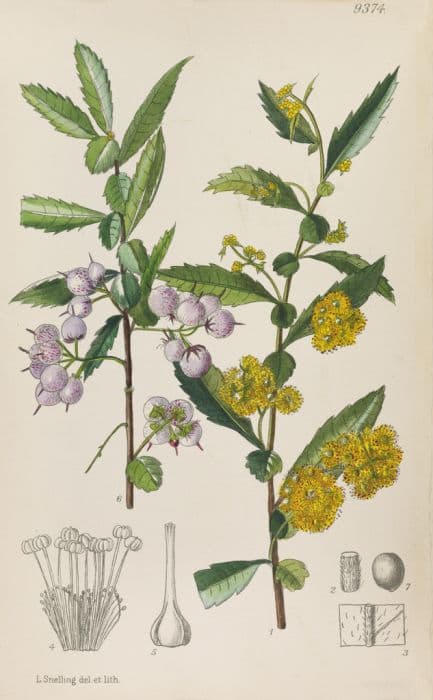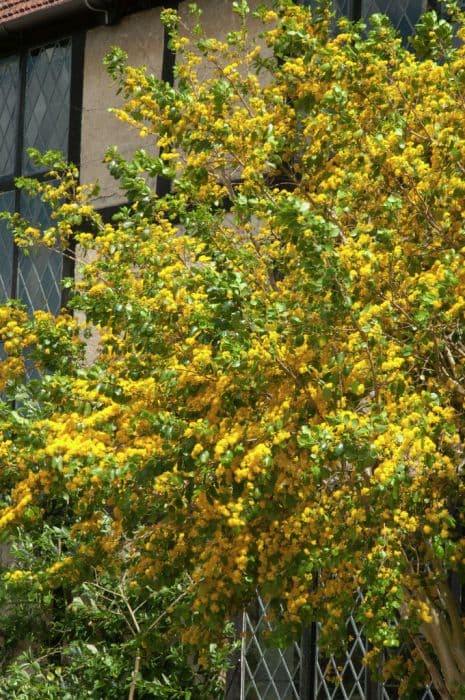Weeping Willow Salix × sepulcralis var. chrysocoma

ABOUT
The plant commonly known as the Weeping Willow has a graceful and elegant appearance, characterized by its distinctive pendulous branches that sweep towards the ground. Its long, slender leaves are light to bright green in color and boast a fine texture, adding to the overall feathery and delicate look of the tree. During the growing season, these leaves typically turn a golden shade before falling off. The Weeping Willow produces flowers, often referred to as catkins, which are fuzzy and add a soft decorative element to the tree during blooming. The bark of the tree is rough and furrowed, providing a contrast to the softness of the leaves and the gentle sway of the branches. Its overall form is rounded and spreading, creating a canopy-like effect that many find calm and serene.
About this plant
 Names
NamesFamily
Salicaceae.
Synonyms
Weeping Willow, Golden Weeping Willow.
Common names
Salix chrysocoma, Salix babylonica var. pekinensis, Salix babylonica var. pendula, Salix sepulcralis.
 Toxicity
ToxicityTo humans
The plant commonly known as Weeping Willow has no significant toxicity to humans. It is not known for poisoning upon ingesting parts of the plant.
To pets
The Weeping Willow is generally considered to be non-toxic to pets. There are no well-documented cases of poisoning in pets from ingesting parts of this plant. However, it is always advisable to prevent pets from consuming plant material, as individual sensitivities may vary.
 Characteristics
CharacteristicsLife cycle
Perennials
Foliage type
Deciduous
Color of leaves
Green
Flower color
Yellow
Height
40 feet (12 meters)
Spread
35 feet (11 meters)
Plant type
Tree
Hardiness zones
5
Native area
Cultivar
Benefits
 General Benefits
General Benefits- Erosion Control - Salix × sepulcralis var. chrysocoma, commonly known as the Weeping Willow, has roots that are excellent for stabilizing soil and controlling erosion, particularly along riverbanks and watersides.
- Habitat Provision - It provides habitat and nesting sites for various species of birds and other wildlife, enhancing biodiversity.
- Shade and Cooling - With its dense foliage and broad canopy, the Weeping Willow offers significant shade, creating cooler microclimates during hot weather.
- Ornamental Value - The tree is widely appreciated for its aesthetic appeal, with its distinctive pendulous branches creating an elegant feature in landscapes and gardens.
- Noise Reduction - Its dense canopy can help absorb sound, making it useful for planting in areas where noise pollution is a concern.
- Windbreak - The Weeping Willow can serve as a windbreak, offering protection for nearby crops, buildings, and recreational areas.
- Soil Improvement - The leaf litter from the tree decomposes to enrich the soil with organic matter, improving soil quality over time.
- Streambank Stabilization - The root system helps stabilize streambanks, reducing siltation in waterways and protecting aquatic habitats.
 Medical Properties
Medical PropertiesThis plant is not used for medical purposes.
 Air-purifying Qualities
Air-purifying QualitiesThis plant is not specifically known for air purifying qualities.
 Other Uses
Other Uses- Willow Art and Craftwork: The flexible branches of the weeping willow can be woven into intricate artworks, sculptures, and decorative pieces.
- Erosion Control: Their extensive root system makes weeping willows suitable for stabilizing soil and controlling erosion along riverbanks and waterways.
- Noise Barrier: The dense foliage can act as a natural sound barrier, making it useful for planting in noisy areas to reduce sound pollution.
- Ornamental Bonsai: Weeping willows are sometimes cultivated as bonsai trees for their elegance and sweeping foliage in miniature form.
- Natural Playgrounds: The low, drooping branches can create natural hideaways and play spaces for children.
- Photography Backdrops: The characteristic appearance of weeping willows makes them a popular backdrop for photographers, especially for weddings and portraits.
- Windbreaks: Planted in lines or groups, they can serve as windbreaks, protecting smaller plants and reducing wind erosion.
- Shade for Livestock: On farms, they provide shelter and shade to animals during hot weather conditions.
- Landscape Aesthetics: Weeping willows are often planted for their picturesque aesthetic, adding value to property landscaping designs.
- Biomass Production: They can be grown for biomass fuel because of their rapid growth and ability to regenerate after cutting.
Interesting Facts
 Feng Shui
Feng ShuiThe Weeping Willow is not used in Feng Shui practice.
 Zodiac Sign Compitability
Zodiac Sign CompitabilityThe Weeping Willow is not used in astrology practice.
 Plant Symbolism
Plant Symbolism- Grief: Also known as the Weeping Willow, this plant is often associated with mourning, perhaps due to its drooping branches that resemble tears.
- Flexibility: The branches of the Weeping Willow are known for their flexibility, symbolizing the importance of being adaptable to life's challenges.
- Healing: In some cultures, the Weeping Willow is seen as a symbol of healing, as it grows vigorously and can often be found by water, which is itself a symbol of life and renewal.
- Letting Go: The tree's unique appearance is also connected to the idea of letting go of past hurts, offering a metaphorical image of release and surrender.
- Protection: In folklore, willows are sometimes thought to offer protection due to their longstanding presence near water sources, providing a sanctuary for various forms of life.
 Water
WaterThe weeping willow prefers consistent moisture and should be watered deeply, so the water reaches the roots. During the growing season, water once a week with about 2-3 gallons for younger trees, and 5-6 gallons for established trees. Reduce watering in the fall and winter to when the soil is dry to the touch. It’s important to not overwater, as standing water can lead to root rot. Adjust watering frequency during periods of extreme heat or drought to avoid stress.
 Light
LightWeeping willows thrive in full sun, which means they require at least 6 hours of direct sunlight each day. The ideal spot for planting a weeping willow would be an open area where it can receive unfiltered sunlight throughout the day. Partial shade is also acceptable, but growth and foliage density may be affected.
 Temperature
TemperatureWeeping willows are hardy in USDA zones 4 through 8 and can tolerate temperatures from -20°F to -30°F in dormancy during the winter. Their ideal growing temperatures during the active seasons are between 50°F and 80°F. Weeping willows may experience stress and potential damage if exposed to temperatures above 90°F for extended periods.
 Pruning
PruningWeeping willows should be pruned to maintain their shape, remove dead or diseased branches, and encourage healthy growth. Prune in late winter or early spring when the tree is dormant. Limit pruning to no more than 25% of the total canopy in a year, focusing on removal of damaged or crossed branches, and shaping young trees. Pruning at the correct time helps minimize stress and prevent sap bleeding.
 Cleaning
CleaningAs needed
 Soil
SoilThe Weeping Willow prefers a well-draining, loamy soil rich in organic matter. The ideal soil pH should be between 6.0 and 8.0. A good mix can be created by blending equal parts of loam, sand, and peat or compost for moisture retention.
 Repotting
RepottingWeeping Willows, being large trees, are not typically repotted. Instead, they are transplanted when young to accommodate their rapid growth. Repot young saplings only if they outgrow their current space, about every 2 to 3 years.
 Humidity & Misting
Humidity & MistingThe Weeping Willow thrives in outdoor conditions where natural humidity levels are typical. It does not require any special humidity adjustments; it will flourish in the ambient moisture levels found outdoors in its growing zones.
 Suitable locations
Suitable locationsIndoor
Not suitable for indoor growth due to size.
Outdoor
Plant in moist, well-drained soil; full sun to partial shade.
Hardiness zone
4-8 USDA
 Life cycle
Life cycleSalix × sepulcralis var. chrysocoma, commonly known as the weeping willow, begins its life cycle as a seed, which germinates in late spring in moist soil conditions. The seedlings quickly establish a root system and a single stem, and the plant enters a rapid growth phase, often growing several feet in a single season. As the weeping willow matures, it develops long, pendulous branches that sweep the ground, and its distinctive leaves emerge each spring after the last frost. Throughout the summer, the plant undergoes vegetative growth, photosynthesizing and storing energy. In the fall, the weeping willow prepares for dormancy by dropping its leaves in response to shorter days and cooler temperatures. Finally, the plant enters a dormant period during the winter, conserving energy and resources until the warmer weather of spring prompts the start of a new growth cycle.
 Propogation
PropogationPropogation time
Spring
The most popular method of propagating Salix × sepulcralis var. chrysocoma, commonly known as the Weeping Willow, is through stem cuttings. To ensure success, this process is typically undertaken in late winter or early spring before the tree has fully come out of dormancy. Cuttings should be about 12 to 18 inches long (30 to 46 centimeters) and taken from new growth of the previous season. After cutting, the bottom end of the cutting is dipped in rooting hormone to encourage root development. The cutting is then planted in moist soil, ensuring that several inches of the stem are buried to provide stability and ample area for root formation. The soil should be kept consistently moist to facilitate rooting, and the cutting will generally take several weeks to establish a healthy root system.









